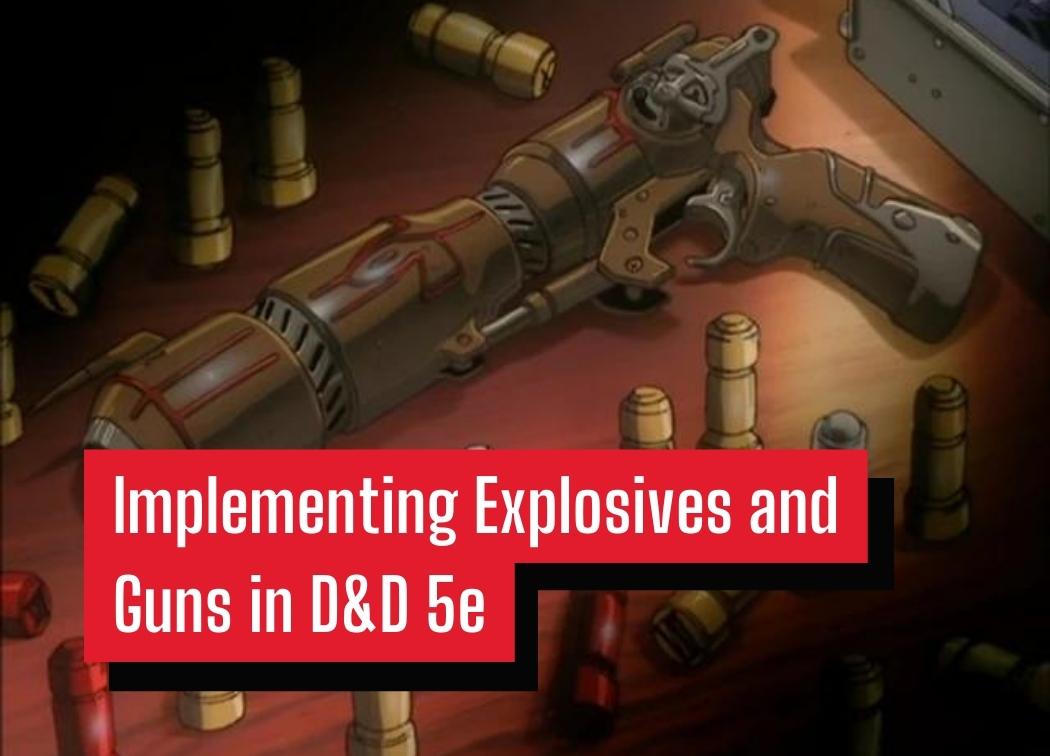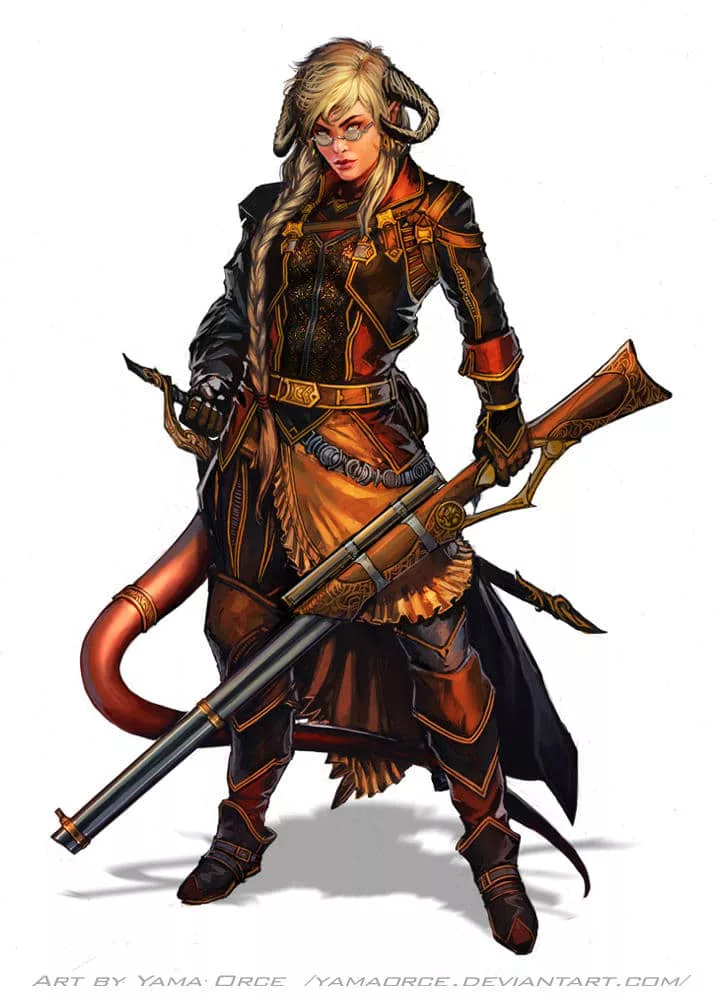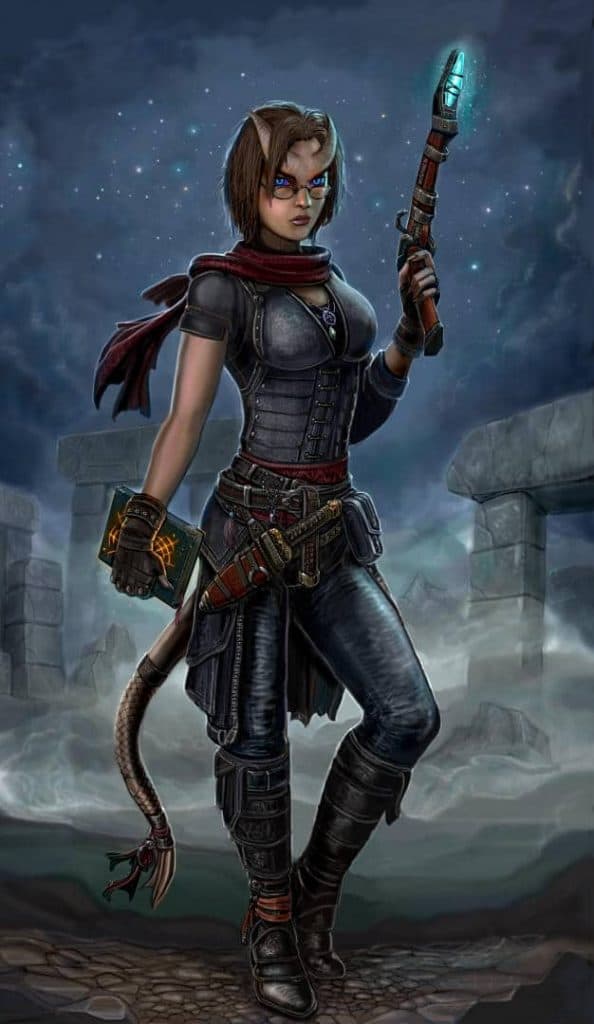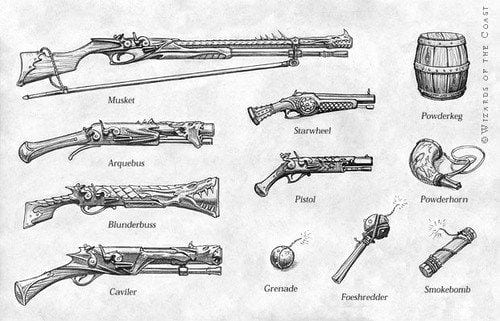Implementing Explosives and Guns in D&D 5e

Explosives and guns in D&D 5e are where many groups draw a line in the sand. Traditionally speaking, it sort of makes sense since most groups opt for a more medieval, high fantasy, or Tolkien-esque setting. There weren’t any guns in any of these settings so it’s a bit jarring to include them.
However, in a game where gods screw around in the material plane and magic is found everywhere guns seem like a weird point to say “no that’s too far, you’re breaking my immersion”. I added them to my long-term campaign and while my players don’t use them I find that they’re a fun addition to the game.
They’re deadlier than your average bow or crossbow, but they have some unique mechanics and drawbacks. I find that this makes for a much more interesting game and gives martial characters some much-needed depth to their ranged weapon arsenal.
Introducing Explosives and Guns
Mechanics
Pages 267-268 of the Dungeon Master’s Guide have the unique rules for guns and firearms as well as a few tables full of firearms and explosives. These weapons are broken into 3 different categories: Renaissance, Modern, and Futuristic.
I’m going to focus on Renaissance Weapons like muskets, pistols, and kegs full of gunpowder. These feel like they fit more naturally in D&D 5e’s combat compared to automatic weapons.
My gripe with the Modern and Futuristic weapons is that they’re just ridiculously more powerful than Renaissance Firearms. Using them is going to change the game from a more traditional D&D game to a constant gunfight. There are systems literally made to deal with modern-day guns and weaponry that I’d rather try instead of reskinning D&D 5e.
Mechanically speaking the Renaissance Firearms are essentially modified crossbows. They have the loading property, more damage, but a shorter range compared to their crossbow counterparts. They’re also a lot more expensive and are potentially harder to find.
The explosives are a bit more interesting. They basically work like miniature Fireballs that are much more expensive and have a smaller range. Honestly, I’d be fine with adding the Modern Explosives outside of the Grenade Launcher to my campaign as they don’t seem very overpowered.

Lore and Flavor
In my home game, I’ve shifted it from a traditional, high fantasy sort of campaign to more of a Napoleonic-era game. There are still swords and melee weapons galore. Some races even prefer to use “ancient” weapons instead of guns and explosives.
It was mostly a matter of reflavoring to get guns to work in a D&D 5e game. The average soldier or adventurer tends to favor leather or cloth armors as they provide more comfort and movement. The heavy metal armors of old don’t hold up well against guns so it makes sense to favor armor that allows you to duck for cover quicker.
Weapon technology has changed, so armor technology will have to catch up to it. Metal armors are modeled more after a Cuirassier or a Dragoon‘s equipment. A full-plate armor set is now a breastplate with some reinforced leather armor to protect the non-vital parts of your body.
What About Power Creep?
When you compare the firearms in the DMG with crossbows and bows you’ll immediately notice that they deal a fair amount of extra damage. That being said, it comes at a cost.
The Renaissance guns are by no means the efficient weapons that we have today. These are clunky, noisy, and of course, expensive to maintain. All of these factors should come into play to help offset the additional damage you’d gain from using a gun instead of a more traditional weapon.
Damage
Both the pistol and musket deal a bit more average damage than your typical crossbow. Thematically this makes sense as a bullet is going to deal a lot more damage to your body than a crossbow bolt.
The pistol is one-handed and deals 1d10 piercing damage or an average of 5.5 per hit. However, it isn’t a light weapon so it cannot be dual-wielded without the Dual Wielder feat. This is how it’s allowed to deal an average of 2 piercing damage per shot higher than its hand crossbow counterpart.
The musket is the two-handed answer to Renaissance Firearms. It deals a whopping 1d12 piercing damage which is an average of 6.5 per hit. That being said it’s only an average of 1 extra piercing damage per hit compared to the heavy crossbow.
Think of the light crossbow as the middle-ground. It deals 1 less average damage than the pistol, but it requires 2 hands to operate.
Range
Like I’ve said before. D&D guns will deal more damage than the other ranged options. It makes both thematic and mechanical sense. However, these old-time firearms are nowhere near as efficient as bows or even crossbows at long distances.
The pistol has a range of 30/90 feet which is respectable when compared to the hand crossbow’s 30/120 feet. However, a light crossbow shoots 80/320 feet making it a much safer option to use. Both the pistol and hand crossbow have their perks, but for maximum survivability, you may want to ditch the guns and hide up in a tree.
The musket doesn’t fare much better than the pistol, unfortunately. It clocks in at a measly range of 40/120 feet. Compared to the heavy crossbow’s 100/400 feet its additional 1 average damage per hit may not be worth losing the safety of a 100 ft. range.
None of these weapons compare to bows though which do deal less damage than their crossbow counterparts. However, a shortbow has a range of 80/320 feet and the longbow can shoot at a range of 150/600 feet. They also do not have to deal with the loading property.

Stealth
Have you ever heard an old musket fire before? It’s loud as hell. Sure your character might be able to sneak behind an unsuspecting guard, but even a Pass Without Trace spell can’t silence the roar of your weapon.
This is a downside to guns and explosives that not a lot of people take into account because it’s not listed as a property of the weapons. However, I can assure you that it’s something your DM will be considering every time you make a shot.
Will your gunfire draw the attention of more guards or henchmen? Sure you’ll deal more damage, but it may be worth it to stow your piece and pull out your trusty bow that’ll make barely a peep.
On the other hand, combat, in general, is pretty loud. The roar of gunfire shouldn’t be a constant setback for your character, but it may be something to be aware of while stealthing.
Ammunition
Ammunition is expensive for firearms. In D&D you generally can retrieve half of the ammunition you use after a battle has taken place. It’s a good way to make up for the fact that ranged martial characters typically spend more money than their melee counterparts.
This all goes out the window for guns though. Ammunition is expended as soon as you roll to attack with a firearm and it cannot be retrieved. Not to mention the fact that 10 bullets cost 3gp while 20 arrows cost 1gp.
The same goes for bombs and powder kegs. As soon as they are lit and exploded there is no way to retrieve the ammunition. You’ll need to use your explosives wisely as they are extremely expensive.
Feat Tax
I’ve chosen to include guns in Crossbow Expert‘s benefit where the user can ignore the loading property of crossbows or guns that they are proficient in. You could certainly make the case that guns are more powerful ergo they shouldn’t get this benefit, but I don’t find that to be very fun.
I also would argue that they have plenty of issues that make their extra damage not always a worthwhile advantage. They’re expensive, noisy, and have a shorter range when compared to crossbows which already have a shorter range than bows.
Allowing a character to use one of their ASIs to get rid of the loading property (among other things) is fair. It’s a tax for characters with Extra Attack that want to use guns just as it is for characters with Extra Attack that want to use crossbows efficiently.

Conclusions
I love the addition of firearms in my D&D games. I feel that it adds yet another layer into character creation and gives ranged weaponry a bit more depth. Sure, guns deal the most damage out of any ranged weapon, but is it worth the cost, lack of stealth ability, and shorter range?
Guns are a high-risk, high-reward weapon to use in D&D 5e. Like the crossbow, they’ll require at least 1 feat to be useful for fighters and other classes with Extra Attack. It’s an investment with an immediate pay-off, but it’s a very different fighting style compared to the other, longer-ranged options.
Explosives serve as a way for martial characters to deal AoE damage. It’s never going to be as deadly as a spellcaster’s AoE attacks, but giving your players an option, albeit an expensive one, is never a bad idea.
The only gripe I have with the DMG weaponry is that there isn’t a lot to choose from. On the other hand, this is the perfect time to learn how to homebrew your own weapons! Variety in weapon choices will always be welcomed by your martial characters.

In historical view point, guns were adapted because of two benefits: 1. Easier to master, 2. Penetration on armor. Accuracy and penetration, eh? It sounds like guns should have ability to ignore some part of AC imo.
The worlds of D&D generally have to have armour that protects against Rocks being thrown, slings, magic missiles, etc. So it is safe to say the properties of the leather and metal are slightly different than that of “our world” AC is as much a success chance to hit. glancing blows, reaction, etc of the other person. As such AC would likely be not be impacted by a musket ball.
If a dragon stomping down on your with a huge force with sharp claws isn’t ignoring your armour class than not much should.
A Bow took training and strength to fire. Several years to know that an archer was going to hit where you want them to. Firearms take handing it to someone. teaching them to load it. then taking 1000 of them line them up and have them fire in generally the same direction. It is significantly less work.
Add to this. that Musket Balls had a chance of getting through armour but not always. Good steel armour could stop musket balls surprisingly well. Particularly in the early days of muskets. Long Bow Arrows also has a chance to penetrate the same armour though. A long bow fired at a shorter range and hitting a flatter part of the armour would penetrate. Not all armour is high grade steel though. Arrows very effective. So long as they were the right kind of Arrow.
For example Norman Knights against Irish warriors using bolts designed for hunting and armoured fighting stood no chance against a Norman even just in chain really. Yet a Arrow designed to penetrate long, thin and squared it changes the game.
So there are a number of factors with this. As such AC would generally speaking be unaffected.
Easier to master, not necessarily better accuracy (If we’re considering the renaissance weapons). With a bow there’s a lot more thought that goes into it, draw, distance, you potentially have to aim up and have the arrow come down where you want. All that being said, an expert archer can land an arrow practically anywhere they want within huge distances. Whereas some of the first firearms were VERY inaccurate, setting off an explosion within a metal cylinder and expecting the exact same outcome every time is unreasonable.
Even many automatic weapons of todays standards can’t do that. Now, with all that being said, I don’t think accuracy is better, and that’s represented by the shorter range on the weapons. I do feel like it’s reasonable to expect the weapons to have better penetration, the only problem with that is within the game that can easily ruin many of the benefits of armor. There would no longer be any point in having players with heavy armor. Everyone would end up just being dex based because it’s more reliable.
So within my game (starting a steam punk style game) I intend on including Kevlar lining in all the equipment to represent the armors ability to withstand bullets. Cloth armor wouldn’t have any, medium armor would have a thin vest covering sections of the body, heavy armor would be entirely lined with it on the inside. I feel like its an easy adaptation to armor that keeps the game balanced. Essentially, if there are weapons within the world, someone’s gonna figure out how not to die from them immediately. Also, thank you to Eldadres for the great write-up on firearms 🙂
In a large scale battle where you’d have rows of conscripts pointing muskets at one another, I doubt many of them were wearing the kind of armor you think. Padded armor, some leather, *maybe* some mail, but very few breastplates, and full plate was reserved for the lords. Also, the term “bulletproof” comes from a time when guns were gaining popularity in the west, and the nobility wanted their armor to be able to withstand the force of bullets.
As for the implementation in a vanilla D&D game, I’d like to try modern firearms as attacking a reduced AC (maybe just 10), but any armor worn reduces the damage by an amount equivalent to it’s bonus (so like, 8 damage reduction for full plate).
I’m planning to run modern semi-auto handguns and rifles with slightly higher damage, magazines, and really high maintenance costs in a pseudo-isekai game though.
My issue with firearms in D&D is with rate of fire. In the real world during the Renaissance (and even later), elite professional military troops were capable of firing 4 times in 60 seconds. Average troops would fire 3 times in 60 seconds.
In D&D5e, a round is 6 seconds. A renaissance era style firearm should not fire more frequently than every other round, which would give 5 shots in 60 seconds, a feat that even the very best marksmen of the Renaissance would have been hard-pressed to equal (and even if they did, it would only have been for an extremely short period before their firearm was so fouled that it would require comprehensive cleaning before it could be used again at all.)
I have a fully automatic dart gun in my game, so so I can get multiple shots without a noise. Plus, it saves on ammo costs.